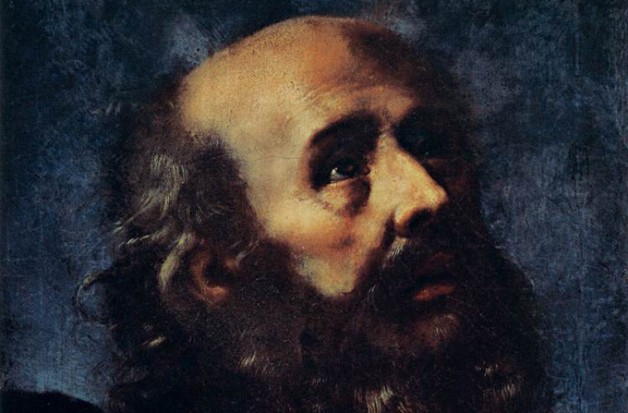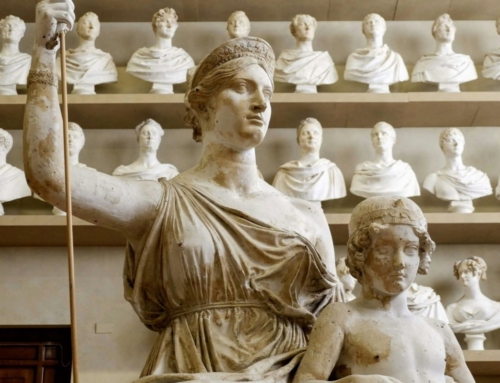Revelation 17—The Woman and the Beast
Then he said to me, “The waters that you saw where the harlot lives represent large numbers of peoples, nations, and tongues… The woman whom you saw represents the great city that has sovereignty over the kings of the earth.”
—Revelation 17:15, 18
We have seen that the immediate historical fulfillment of the wickedness and persecution prophesied in the Book of Revelation is pagan Rome. This is shown by many details accessible to historical inquiry. The footnotes of the NABRE are very good for these. The notes also give some of the symbolic meanings, but of course do not engage in a full explanation of how it all works.
Readers who have been following the NABRE notes or another modern commentary may have noticed how hesitant they are to pronounce on the mechanics of how the revelation to St. John took place. For instance, the NABRE introduction to the Apocalypse says that the symbolic language of the book draws extensively on the Old Testament and adds: “Whether or not these visions were real experiences of the author or simply literary conventions employed by him is an open question.” This may sound startling, as though they were contradicting what we know in faith, that the Book of Revelation is real revelation from God and not merely a literary expression of a man’s religious feelings, aspirations, or personal reflections on history.
But wondering about the way St. John received the apocalyptic revelation is not as bizarre as it sounds. Medieval interpreters such as Peter Lombard and St. Thomas Aquinas considered that, in the highest sort of prophecy, the prophet had his intellect enlightened by God without needing to have words, pictures, or images of the imagination to manifest the revelation. Moses seems to have enjoyed some privileged encounter with God analogous to the medieval idea of an image-less vision; as the Book of Numbers says,
The LORD said: Now listen to my words: If there are prophets among you, in visions I reveal myself to them, in dreams I speak to them; Not so with my servant Moses! Throughout my house he is worthy of trust: face to face I speak to him, plainly and not in riddles. The likeness of the LORD he beholds.
—Numbers 12:6-8
St. Thomas Aquinas considered that Moses and St. Paul (see II Cor 12:1-10) at times actually beheld God in his very essence as the blessed do in heaven, in addition to receiving the most excellent sort of image-based prophetic visions at other times. He says that David also had purely intellectual visions nearly as excellent as Moses’.
The editors of the New American Bible are open to the possibility (though they cautiously hold back from deciding the matter) that the Book of Revelation is the fruit of this sort of most excellent prophetic vision. According to this view, St. John received a purely intellectual and image-less vision of God and was charged with conveying its content to the Church, after which he used the language of Old Testament imagery to symbolize the ineffable truth of God under the guiding inspiration of the Holy Spirit.
I think it is more probable that St. John actually saw the images as well as receiving the intellectual enlightenment, however. According to St. Thomas Aquinas, an image-vision where one sees an image of God as the revealer is the highest kind of image-vision. St. John saw Jesus, the most excellent image of God.
Returning to the image of the city with which we began, we can see many layers of meaning in the great city if we look with the eyes of faith. In these further fulfillments, it is less profitable to look for a geographical city than to realize that the Book is making spiritual realities visible.
The great city is called Babylon, but also “Sodom,” “Egypt,” and the city “where indeed their lord was crucified” (Rev 11:8, and see note). In other words, it is all the wicked together, viewed as one “great city.” It is this, contrasted with the one great New Jerusalem, that is the source of St. Augustine’s doctrine of the “two cities.” Augustine developed these ideas in his massive work The City of God, in which he explains how the world is divided into two spiritual “cities,” one of the wicked and one of the good. Because these are spiritual states and not physical cities, no one can tell who belongs to which “city;” the just and the unjust alike live mixed together everywhere in the world. Only at the Last Judgment will they be sorted out, forever. The prefigurement of this in the Old Testament is the departure of God’s people from Babylon, where they had been living among the Babylonians as exiles from the holy land, as prophesied in Isaiah 52.
Thus when God says, “Depart from her” (18:4), meaning the wicked city, he is not commanding an evacuation from a geographical location but separation from sinners.
The wicked city is the city that “has sovereignty over the kings of the earth.” The servants of Christ cannot expect to conquer the world except by the victory of Christ. That victory in the New Jerusalem of God is the final goal and consummation of the Book.
Image: Carlo Dolci, Moses







